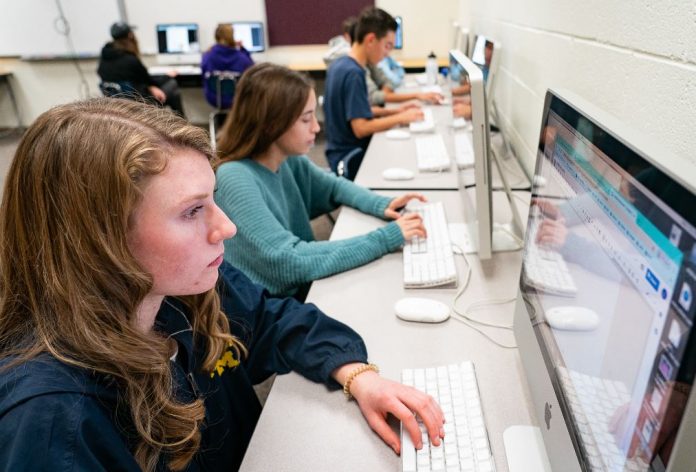
Though they have only been in high school for a little over a semester, some Sedona Red Rock High School freshmen are already progressing into the world of college. A new Early College Program launched at SRRHS Jan. 6, and with it, select freshmen started taking Yavapai College classes along with their high school ones. By the end of their senior years, the 10 students will have taken all 34 credits from Yavapai College needed to obtain an Associate’s degree, while simultaneously getting enough high school credits for their diplomas.
Since Yavapai College’s commencement is held earlier in the month than SRRHS’ graduation, these students will actually receive their Associate’s in General Studies at the Yavapai College commencement a few days before their high school graduation.
On Jan. 22, the freshmen in the Early College Program filed into the Red Rock Academy classroom for their sixth block at 2:15 p.m. Essentially a computer lab, most students pulled up their Yavapai College modules, quizzes or essays without prompt from classroom monitor Brenda Cady.
All freshmen taking classes at Yavapai College – whether 14, 19 or 49 years old – have to take the school’s College Life orientation and module, which explains how to adjust to the college lifestyle.
“It’s basically just telling you it’s going to be different than high school,” Max Metzger, an Early College Program participant said. “It is kind of funny. It doesn’t actually know that I’m a Freshman still. They think I’m a Freshman in college.”
Although the first course topic may seem a bit humorous providing the circumstances the work that goes along with it certainly keeps the students busy.
“We have two or three things that we have to write, and they all have to be 250 words,” ECP participant Jillian Grondin said, adding that there is a discussion board, journal and expansion activities for each module, as well as reading and a video before a quiz.
While some quizzes are multiple-choice and can be automatically graded, a Yavapai College instructor remotely grades the other student content.
“It’s just a lot of reading and writing, that’s all it is. It takes a lot of time,” Grondin said. “Sometimes I get kind of scared cause I feel like I’m not at the level of college writing, but I think I’m definitely getting better because we’re writing so much and I think I’m definitely improving.”
The students approved for the ECP were carefully evaluated, along with their past grades, before they were deemed ready to handle the responsibilities of college classes as well as their high school ones.
“We selected a very, very talented group of students,” said Jennifer Constantineau, who is a SRRHS counselor and also mentors students in the ECP. “This isn’t a watered-down program. . . . It is pretty rigorous, and once we explain that to kids and parents then it’s easy to weed out the kids who are serious about this.”
Constantineau and fellow counselor Deanna Hernandez introduced the program to incoming ninth graders and their parents at Freshmen Night over the summer, and interested students were asked to fill out applications, and then go through interviews with the counselors and Superintendent/ SRRHS principal Dennis Dearden.
Some of the interview questions included, “How do you feel that this program will help them in your future?” and “What do you see yourself doing in the future?”
While many 14-and 15-year-olds might not know what they want to do next weekend, let alone after high school or college, the case is different with ECP freshmen.
Leah Pederson plans on being an orthodontist, like her grandfather. She even knows that after she graduates SRRHS and gets the YC degree, she wants to go to University of Washington for her Bachelor’s degree and University of Michigan for dental school.
“I chose to apply to this program because its better financially, its better time-wise,” she said, adding that she knows being an orthodontist takes years of college, and getting two years out of the way in high school will give her a head start.
Grondin, who said she plans on being a forensic investigator, agreed.
 “It helps with time because [after] high school, people go to college and then they have to wait four years,” she said. “I’d already be two years ahead of everyone, so it’s gonna help out in the future.”
“It helps with time because [after] high school, people go to college and then they have to wait four years,” she said. “I’d already be two years ahead of everyone, so it’s gonna help out in the future.”
But in the short term, while Grondin balances high school, college and sports, time is not exactly on her side. Outside of that sixth-block class set aside for the ECP students, Grondin said she spends around 40 minutes to an hour on her Yavapai College work, in addition to high school homework and studying. She also plays Junior Varsity basketball.
“If it’s an early [basketball] practice then I have more of a time frame,” she said of time at home for schoolwork. “If I get out of practice at like 7:30 p.m. then I only have a couple of hours.”
Constantineau said that Yavapai College has assured SRRHS administrators that “they will continue working with our schedule to make sure students can participate in a fully traditional high school experience while obtaining their two year college degree,” including extracurricular activities like sports and theater.
Bryan Munsterman, 15, said the time management aspect he is having to learn by taking Yavapai College classes is “extremely useful” to him as someone who struggles with that. The challenge that the college classes offer was also one of the things that Munsterman was drawn to when deciding to apply to the ECP.
“At first when I [learned about the ECP] I knew it was going to be a lot of work. And honestly, I knew I needed it,” he said. “Because usually if I don’t have a good motivation for a higher goal I usually just skim over stuff and do sub-par while I could be doing much better if I actually tried. . . . Now that I’m knowing that I can get two years of college education in high school, this is a big step. And I’m going to be putting a lot more time and effort into this.”
Munsterman said that his dream is to become an astrophysicist after college. But if that doesn’t work out, he said he’ll “be able to settle for a job with slightly above average pay.”
Another draw to the program is that through the high school’s partnership with Yavapai College, the school district pays for the majority of the tuition, with the high schooler’s family only having to pay for books and student’s fees. However, if the student doesn’t finish the program, then the family is responsible for paying the school district back.
To pass a Yavapai College class, students need to get a “C” or higher.
“Once you enroll, that’s part of your college transcript, so that could determine what four-year college you get into,” Constantineau said. “We talk a lot about how it looks and how what they’re doing now could affect them in the future, positively and negatively.”
There is no cap on how many freshmen can join the ECP so far, but that may have to change if it continues to grow in popularity. And based on the positive feedback that Constantineau and Hernandez have received so far, growth is a very likely possibility.
“I actually had a mom call me this morning about the program to make sure that her fifth grader is prepared for it,” Hernandez said. “So there’s a lot of interest, not just from our younger grades, but from the community in general. Kids are really looking at this as a great opportunity.”


















